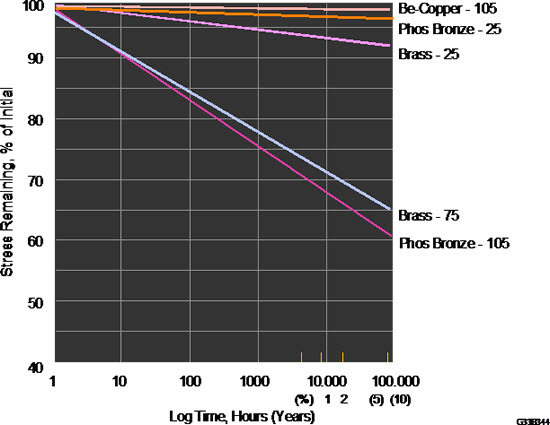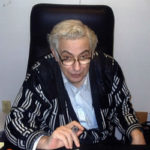Stress Relaxation I – Mechanisms, Materials and Temperature
Stress Relaxation I
Mechanisms, Materials and Temperature
In the metallurgical world, stress relaxation is defined as a time-dependent loss in stress at constant strain. OK, you may ask, but what does that have to do with connectors? It’s all about contact force. The contact normal force is a critical design parameter for connectors, because the contact force creates the electrical contact interface on mating and maintains the integrity of that interface over the application lifetime. So, in connector speak, stress relaxation results in a time-dependent loss in contact force when mated (at constant strain). This loss in contact force can result in mechanical instabilities, which, in turn, can lead to degradation in contact resistance.
The contact normal force of a cantilever (straight, single-supported) contact beam, with common contact-spring geometry follows:
FN = s/6 w ( t/l2)
Where FN is the contact normal force, s is the stress created during the deflection of the beam, and w, t, and l are the beam width, thickness, and length, respectively. The contact force varies directly with the stress in the beam. The detailed form of equations relating force to stress, of course, varies with the beam configuration. But, in all cases, stress relaxation directly results in a decrease in the contact force. We will discuss what this means with respect to connector performance in an upcoming article. This time, we’ll address the mechanism of stress relaxation and its dependence on material and temperature.
The mechanism of stress relaxation occurs at the atomic level. When stress is applied to a contact beam — in connectors, generally a bending stress — individual atoms and planes of atoms move relative to one another as the beam curves under the stress. The movement of planes of atoms, called dislocations, can be complex, and the number and distribution of dislocations is determined by the stress pattern in the material. Dislocation densities are highest in high stress areas. In the case of cantilever beams, this would be the base of the beam at its support point. Dislocations are non-equilibrium, high energy regions, and the individual atoms in the dislocation will tend to return to lower energy equilibrium positions by self-diffusion within the metallic crystalline matrix with time and temperature. This lowers the energy in the system and is the basic mechanism of stress relaxation and the relaxation in contact force.
Self-diffusion is temperature dependent, and, therefore, the rate of stress relaxation is temperature dependent. In fact, self-diffusion rates vary exponentially with temperature. In addition, the activation energy for self-diffusion is material dependent and, therefore, copper alloys will show different stress relaxation rates and temperature dependencies. These differences are apparent in Figure 1.
 Figure 1: Stress Remaining (Contact Normal Force Remaining) versus Aging Time
Figure 1: Stress Remaining (Contact Normal Force Remaining) versus Aging Time
Note that Figure 1 shows the percentage of initial stress remaining as a function of time at temperature. Given that contact force varies directly with stress, the same percentages would apply to contact force. The figure shows the stress relaxation performance of three different copper alloys — brass (70Cu30Zn), phosphor bronze (95Cu5Sn), and beryllium copper (98Cu2Be). The numerical values attached to the various curves indicate the temperature, in degrees centigrade, to which the alloys were exposed during aging.
Consider the brass and phosphor bronze data first. Note that the “room temperature” (25°C) performance is similar for both materials. If the contacts manufactured from both materials had an initial contact force of 100 grams, the contact force after 100,000 hours would be approximately 96 grams for phosphor bronze and 91 grams for brass. This level of variation would most likely not affect connector performance. Higher temperature aging, however, does show significant differences in stress relaxation between brass and phosphor bronze. Brass aged at 75°C would show a contact force decrease from 100 to about 65 grams, 35% at 100,000 hours. In contrast, phosphor bronze contacts aged at 105°C would show a decrease from 100 to about 60 grams, a 40% decrease in contact force. The variation is about the same in the two cases, but the phosphor bronze was aged at a 30°C higher temperature. Recalling that the rate of stress relaxation varies exponentially with temperature, the phosphor bronze is showing a significantly better stress relaxation resistance than the brass.
Both brass and phosphor bronze, however, show much higher stress relaxation rates than beryllium copper. After 100,000 hours at 105°C, the contact force of beryllium-copper contacts decreases from 100 to about 98 grams! Why the dramatic difference? The difference is due to the range of strengthening mechanisms in the three materials. Two strengthening mechanisms, alloy and work hardening, are active in all three materials. Alloy strengthening occurs at the atomic level and arises from different atomic size and chemical effects and is generally stable. Work hardening is another example of the effects of dislocations within the metal matrix. Strip materials achieve their strength levels through the rolling processes that take them to the final desired strip thickness. The rolling process introduces dislocations into the strip, which increases both the hardness and the yield strength. The more reduction in thickness that takes place in the final stages, the higher the yield strength of the material. Recall, however, that dislocations will move to reduce their energy with time at high temperatures, the basic kinetics of stress relaxation. Brass and phosphor bronze exhibit only the alloy and work hardening strengthening mechanisms, so show similar performance.
Beryllium-copper has an additional strengthening mechanism, second phase strengthening. The mechanism of second phase strengthening is very simple in principle. A controlled distribution of small second phase particles is produced within the basic copper matrix by a variety of thermo-mechanical processes. This distribution of particles acts to inhibit the motion of dislocations and, therefore, the reduction in the stress within the copper matrix. This geometric effect is much less sensitive to thermal exposures, so beryllium-copper has a much higher stress relaxation resistance than brass or phosphor bronze or any other copper alloy that relies on only alloy and work hardening strengthening mechanisms. This is demonstrated in Figure 1 by the 98% stress remaining (contact force remaining) after 100,000 at 105°C. For completeness, another aspect of second phase strengthening is its effect on yield strength. Inhibiting dislocation motion also increases yield strength as is demonstrated by the fact that while phosphor bronze yield strengths can approach 100ksi, beryllium copper alloys can approach 200ksi.
So, stress relaxation results from atomic rearrangements due to thermally assisted self-diffusion, which reduces the stress level in the deflected contact spring. This reduces the contact normal force, which may decrease the mechanical stability of the contact interface, and make the interface susceptible to micromotions and increased contact resistance. Check back in the next issue of Connector Supplier to learn how this motion susceptibility plays out in the application environment.
- Nanocrystalline Silver Alloy Contact Finishes in Electronic Applications - April 6, 2015
- Nanocrystalline Silver Contact Platings - March 16, 2015
- Dr. Bob on Gold Flash Contact Finishes (and Max Peel) - September 22, 2014






